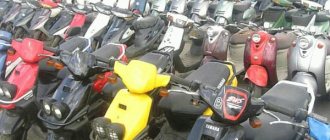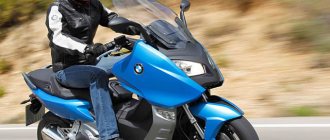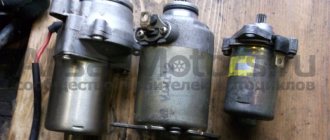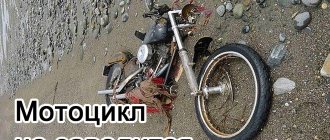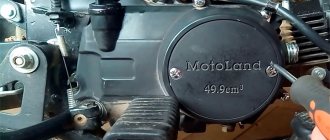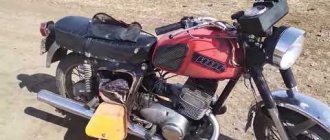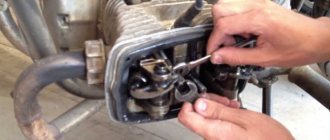Very often on various forums people ask questions like “Why does my moped stall and won’t start?”, and often receive a bunch of advice on what needs to be replaced, even advice to change the moped to a “cooler” one. In fact, even a technically untrained person can diagnose the main engine malfunctions. Let's sort it out in order.
So, for stable operation of the engine, three conditions are needed:
- A good spark on the spark plug electrodes, at the right moment.
- The presence of the “correct” working mixture in the combustion chamber.
- The presence of “compression”, that is, a working cylinder-piston pair and properly functioning valves.
You don't need to be an experienced mechanic or have a bunch of expensive tools to diagnose your moped. Let's look at simple methods for finding a fault.
Visual inspection
You should always check using the “from simple to complex” . If the moped was working like a clock just yesterday, but today it refuses to start, remember what happened to it during this period of time. Maybe you made changes to the electrical circuit, or adjusted the carburetor, or washed the moped, or did some other work - sometimes this helps to localize the fault. If possible, return everything back.
Before starting the test, carefully inspect the moped. You may notice a torn or exposed wire or some other small thing. Sometimes this helps a lot.
Checking the presence of a spark and the condition of the spark plug
This is the simplest check that every moped owner can carry out, having only a spark plug wrench or a spare spark plug on hand. Moreover, if you unscrew the spark plug from the engine, you can at the same time assess its condition and understand by the color of the carbon deposits how correct the working mixture is being prepared by the carburetor.
So, if you unscrew the spark plug from the engine, pay attention to the carbon deposits that cover the central electrode. The carbon deposits should be brown or light brown in color. If the carbon deposits are black, this indicates that the mixture is too rich, or the spark plug is faulty, or the engine is “eating” oil. Perhaps this is the reason for poor engine performance.
Also pay attention to the presence of liquid on the candle. If the spark plug is “wet”, that is, there is gasoline on the spark plug, then gasoline still enters the combustion chamber, but does not ignite. There are at least three reasons why a spark plug may be wet:
- trying to start the engine with the ignition turned off - if you turn the engine with the kick starter for a long time, the spark plug will simply flood with fuel and it will not be able to work normally. To solve the problem, the candle needs to be dried, for example, heated with a lighter.
- The spark plug is faulty - if the spark plug insulation is broken or the gap is broken, the spark plug will not work normally. Only replacing the spark plug with a known good one will help here.
- ignition system faulty
Now we put the tip on the spark plug and press it to a metal surface, for example, to the engine head, turn on the ignition and turn the engine with the kickstarter. It is more convenient to check the spark together, so that one person holds the spark plug and the other turns the engine. But in principle, one person can handle it. Be careful - there is high voltage at the center electrode of the spark plug.
If there is no spark, then the ignition system is at fault. Check all wires for breaks or shorts to ground. All electrical wiring connectors must be connected. If possible, replace the ignition coil with a known good one. Check if the generator coils are damaged. You can read more in the article “The moped has lost its spark, what should I do?”
If you can’t figure out the wiring, contact someone who knows how to do it.
If there is a spark, then most likely the problem is in the power system. Screw the candle into place and continue.
WHAT TO DO IF THERE IS NO TRACTION IN THE CARPATHIANS?
WHAT TO DO IF THERE IS NO TRACTION?
If the traction is lost, when you give the gas the engine works in a tense manner and does not pull.
There are several reasons:
1. Check the tightness of the head - tighten the 4 nuts on the head.
2. There is not enough air when the fuel-air mixture ignites; there is a lever on the side of the carburetor that opens and closes the air supply. You need to press it and do not give more than half of the gas until the mokik warms up.
3. The air filter is clogged. Remove it and clean it, replace it if possible. Pay special attention to the rubber adapter between the filter and the carburetor, everything must be sealed.
4. The candle does not work well. Check the spark plug, if it is wet, burn it or clean it. If the gap is out of order, adjust it to 0.5-1.5mm. if the spark is small and not constant, check the bobbin - it can pierce the body. All contacts must be well cleaned and insulated.
5. The ignition should match the mark on the engine crankcase. If the engine is overhauled, the ignition must be adjusted independently.
6. Engine overheating. Let it cool, under no circumstances douse it with water, he doesn’t like that. You need to let it cool gradually.
7. Fuel quality. Fill with proven fuel and mix it with oil correctly. The mixture should not exceed the norm, otherwise there will be a lot of smoke and a decrease in the rate of combustion.
karpati-tyaga.blogspot.com
Checking the engine power system
First of all, you need to make sure that there is enough gasoline in the gas tank. There is a small tube inside the gas tank that takes gasoline not from the bottom of the gas tank, but a little higher. Therefore, it may turn out that there is still gasoline in the tank, but it does not flow into the carburetor. Therefore, if possible, add gasoline to at least half the tank and try to start the moped again. Perhaps this is the reason.
You also need to know that the gas tap of the Alpha moped has two positions: in one, it takes gasoline closer to the bottom of the gas tank, and in the other, a little higher. If you don’t know in which position the gas tap is open, try installing it in a different position, maybe this will help.
It is very convenient to check the gasoline supply if you have a transparent tube from the gas tank to the carburetor, or have a replaceable gas filter installed. In this case, you can immediately see whether there is gasoline or not.
There is also another simple check of the power system: take a small amount (5-10 ml) of gasoline into a syringe, remove the air intake tube from the carburetor and pour gasoline directly into the carburetor. If after this the moped starts up, or as they say “catch,” then the reason is definitely in the gasoline supply and you need to check the fuel supply and carburetor.
If after all the described checks the problem is not found, there is one more check left - checking the engine compression.
We measure compression
Compression is the pressure in the cylinder at the end of the compression stroke. The magnitude of this pressure allows you to assess the condition of the engine. A working Alpha moped engine should have a compression of at least 8-10 kg/cm² (“atmospheres”) . If it is less, then the engine is faulty: either the piston rings are worn out or the valves are leaking. Most likely the engine will need to be disassembled.
Compression is measured using a compression meter - a special pressure gauge that is inserted or screwed in (depending on the design) instead of the spark plug.
Before measuring compression, it is advisable to warm up the engine, but if it does not start, you will have to measure it cold. It is also advisable to unscrew the carburetor or open the throttle valve and turn off the fuel supply.
The engine must be rotated using an electric starter or kickstarter until the compression meter readings stop increasing.
When the compression is less than 8 atmospheres , you need to pour 10-15 ml of engine oil into the spark plug hole using a syringe. If after this the compression increases noticeably, it means the piston rings are worn out . If not, then the problem is in the valves or camshaft drive . The most common reason: the camshaft drive chain is broken or has slipped, or the valves are bent/broken.
MOPED-TINY
The small-sized moped I designed, unlike serial ones, can be easily placed in a passenger elevator. This is, perhaps, one of its main advantages, since a two-wheeled baby (which, by the way, develops the same speed as the Riga-7) can be “parked” on the balcony of a city apartment.
The frame for the moped is taken from a children's bicycle of the Renak brand with a standard drive sprocket, carriage, pedals and connecting rods. The rear wheel fork is reinforced with a brace, and the horizontal pipe between the saddle and the handlebar gives additional strength to the frame.
The front wheel fork is telescopic, with spring shock absorption (springs with struts are borrowed from a motorbike). The handlebars are from a standard racing bike; The throttle and clutch control cables are routed inside the steering wheel.
Engine brand D-6. The drive chains are covered by a lightweight hood that is attached to the frame with a single screw. The hood configuration provides access to the spark plug, carburetor button and air filter.
Moped layout:
1 - hood, 2 -. muffler, 3 — fuel tank, 4 — carrying handle, 5 — D-6 engine, 6 — telescopic shock absorber, 7 — tension roller, 8 — strut lock, 9 — strut, 10 — strut latch.
The wheel rims are from a children's scooter. The rear wheel axle is bicycle, with a brake hub. A sprocket with 18 teeth is attached to it on splines. The number of spokes had to be doubled for strength (32 instead of 16), using shortened moped spokes Ø 3 mm. The same spokes are installed on the front wheel instead of the standard ones.
A few words about other details of the mini-moped. The saddle from Riga-7 provides a comfortable fit. Homemade cylindrical fuel tank with a capacity of 2.5 liters. It is secured with one hinged bolt. A roller for tensioning the pedal drive chain is mounted on the frame strut. There is a carrying handle under the saddle (at the center of gravity of the moped).
The tires are from a children's scooter. To strengthen them, the same one is glued into the main tire, but turned inside out. Such a “sandwich” can be fastened with 88N glue or a composition of 100 parts thiokol and 30 parts hardener. A freshly glued tire with a tube is put on the rim, inflated with a pump and dried for two days.
M. VYSHINSKY, Moscow
We recommend reading
- TANK DESTROYER “CENTAUR” In the 1980s, the Italian army developed tactical and technical requirements for a promising family of tracked and wheeled armored combat vehicles, which were planned to be launched in…
- CLOTHESPECK-PULLER One day I was working with manuscripts in the shade of a branchy tree. Suddenly, one of the paper sheets was picked up by a gust of wind and lifted quite high, where it got stuck among the branches. Even with...
Checking the ignition timing
If there is a spark, fuel is supplied, compression is fine, but the moped still does not start - the ignition timing may be off.
On 139fmb engines, which are installed on alpha, the ignition timing is not adjustable. It is rigidly determined by the position of the flywheel on the crankshaft. The engine crankshaft on the generator side has a conical surface on which the flywheel (also known as the generator rotor) is tightly seated. The correct position of the flywheel is set using a key that is inserted into the crankshaft keyway.
You can check this visually (remove the generator cover, unscrew the nut securing the flywheel and see if the grooves match). But the groove on the crankshaft cannot always be seen (depending on the specific instance), so there is a more reliable way: buy or borrow a strobe light from someone (many car repair shops have one), unscrew the plug on the generator cover and check that flashes occur at the same time the label || appears in the window.
"Delta" (V-50M) does not pull. / Help / MotoScoot - motorcycles and scooters
Such a thing, I took a Soviet Delta (used). I didn't go from the very beginning. The former owner said that he had just changed the rings and were getting used to them. I drove it around a bit, but it didn't get any better. When replacing the crankcase (the old one was cracked), I replaced the piston and rings with new ones (there was a small groove on the piston, apparently from a grain of sand; one ring was broken), it still doesn’t work. The clutch doesn’t slip, it just stalls on a flat road in first gear from lack of traction, it only goes uphill and then you have to push it with your feet.)) The carb (K60) has been adjusted. The only thing I don’t like is the jet, the hole in it is too large and somehow crooked.)) Does anyone have any ideas on how to make it go at least 40-50 km/h? PS I did not set the ignition (perhaps too early). Can anyone tell me how to do this correctly? It starts with just a click, the engine runs smoothly without load, and picks up speed well. When starting, when I slowly lower the kick starter, I hear some hissing, as if air is being sucked in. Is this how it should be or is there still a leak in the cylinder?
motoscoot.ru
If the moped is not
Sometimes it happens that the moped does not want to start after several hours of inactivity. However, after warming up, it works and starts stably. Let's figure out why this happens.
When the engine is cold, all clearances (in the piston, in the valves, etc.) are far from ideal. Plus, when fuel gets on cold engine parts, it evaporates worse and therefore ignites worse. Because of this, during a cold start the engine needs a richer mixture than usual. It is for this purpose that devices are made on carburetor engines to enrich the mixture at start-up.
On the Alpha moped (and similar ones), an air damper is installed. It reduces the air flow and thereby enriches the working mixture. The damper has two positions: “closed” - the lever is raised up, “open” - the lever is lowered down. When starting “on a cold” air damper must be closed (lift the lever up) . When the engine runs for a while with the throttle closed, it needs to be opened. Driving with the throttle closed will lead to increased fuel consumption and the formation of carbon deposits on the spark plug and piston.
What to do if a cold moped does not start even with the throttle closed? Try using a syringe to fill in 5-7 ml. gasoline directly into the carburetor inlet pipe. If the moped starts after this, then the carburetor needs to be adjusted. If it doesn’t start, check the spark and compression (see above).
